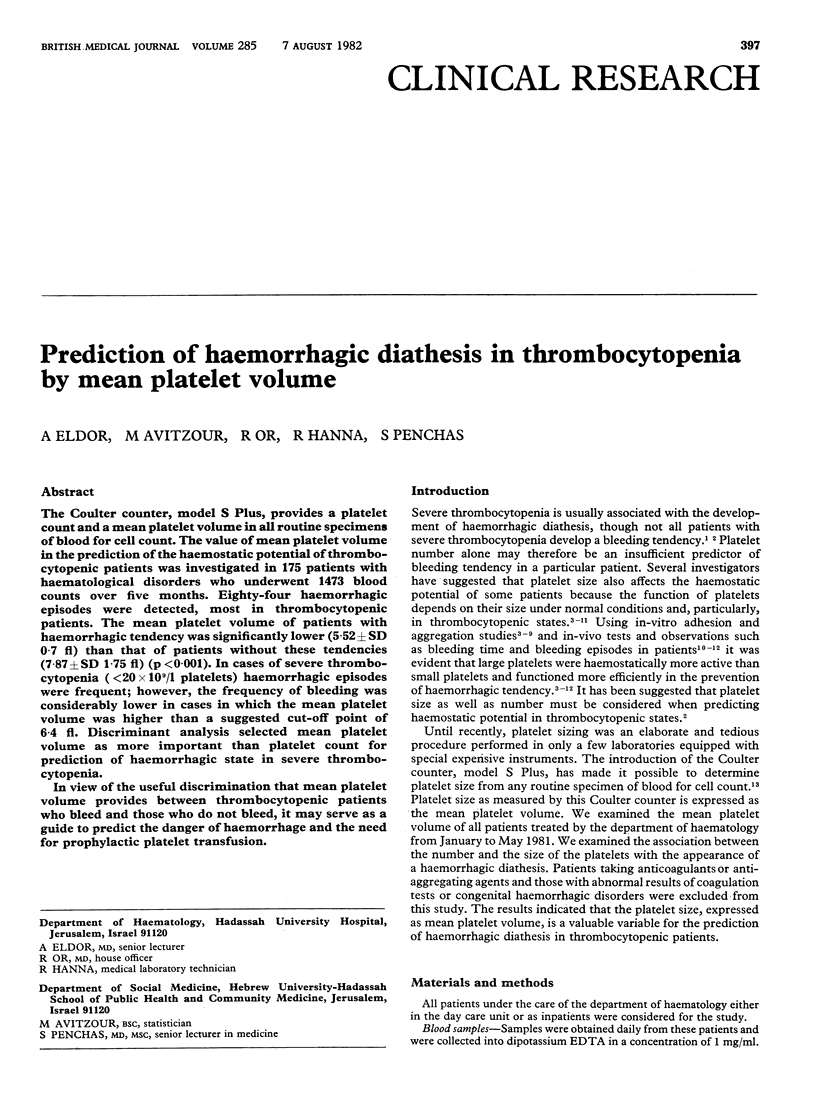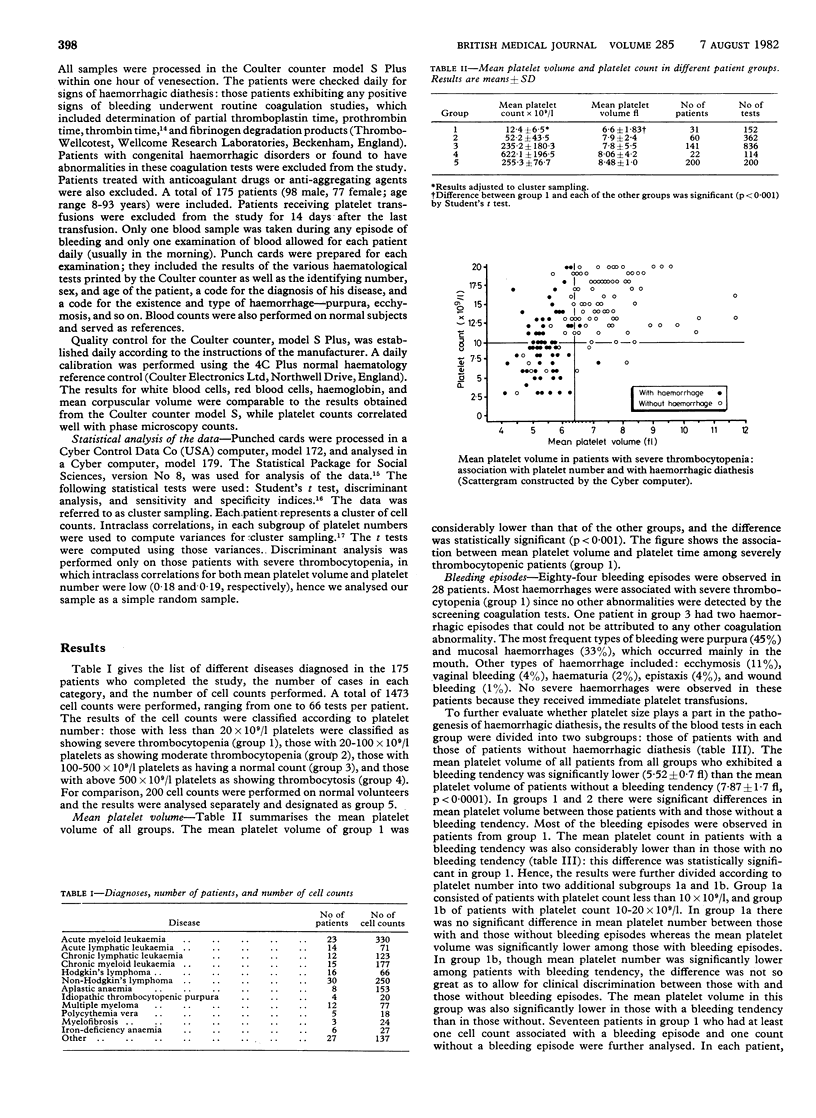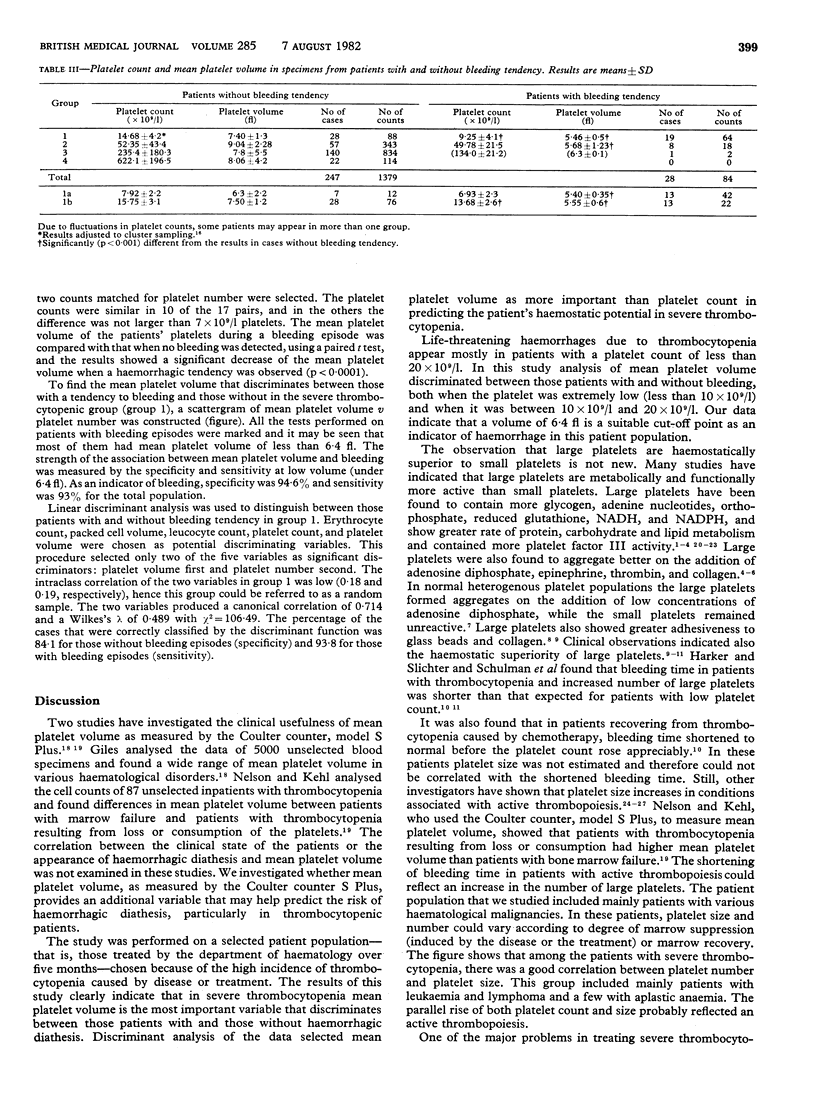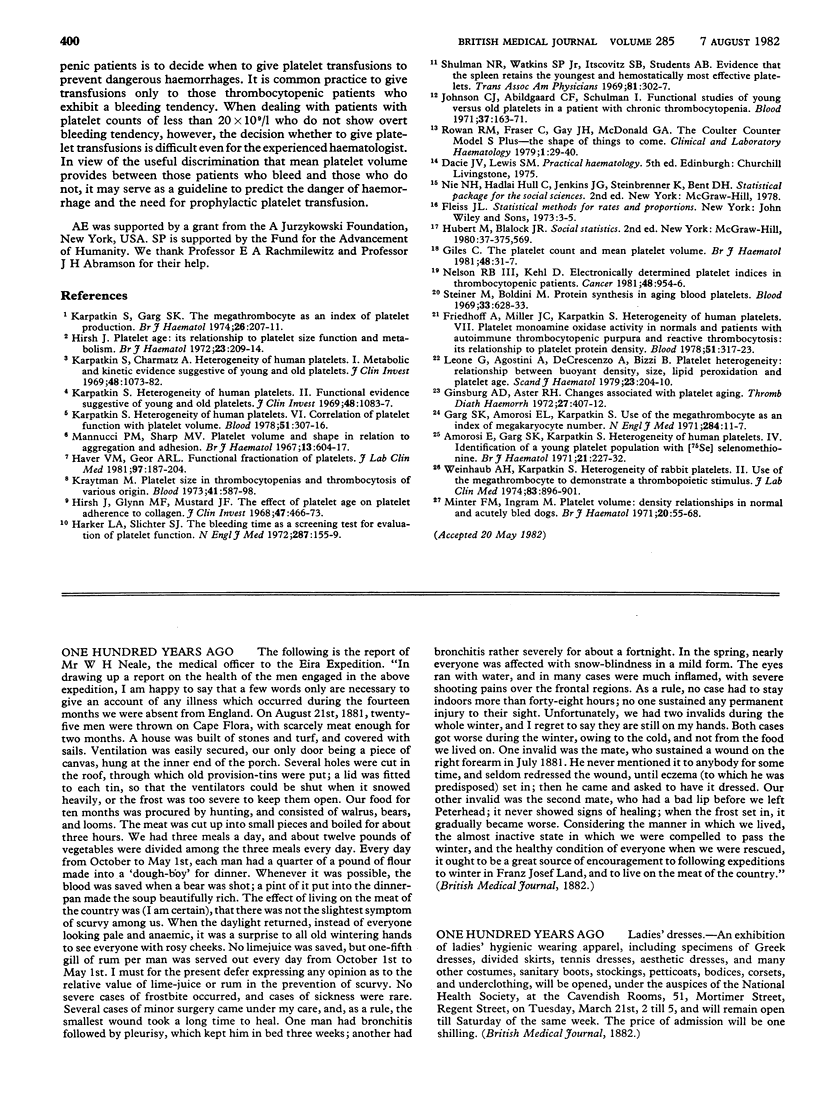Abstract
The Coulter counter, model S Plus, Provides a platelet count and a mean platelet volume in all routine specimens of blood for cell count. The value of mean platelet volume in the prediction of the haemostatic potential of thrombocytopenic patients was investigated in 175 patients with haematological disorders who underwent 1473 blood counts over five months. Eighty-four haemorrhagic episodes were detected, most in thrombocytopenic patients. The mean platelet volume of patients with haemorrhagic tendency was significantly lower (5.52 +/- SD 0.7 fl) than that of patients without these tendencies (7.87 +/- SD 1.75 fl) (p less than 0.001). In cases of severe thrombocytopenia (less than 20 x 10(9)/1 platelets) haemorrhagic episodes were frequent; however, the frequency of bleeding was considerably lower in cases in which the mean platelet volume was higher than a suggested cut-off point of 6.4 fl. Discriminant analysis selected mean platelet volume as more important than platelet count for prediction of haemorrhagic state in severe thrombocytopenia. In view of the useful discrimination that mean platelet volume provides between thrombocytopenic patients who bleed and those who do not bleed, it may serve as a guide to predict the danger of haemorrhage and the need for prophylactic platelet transfusion.
Full text
PDF



Selected References
These references are in PubMed. This may not be the complete list of references from this article.
- Friedhoff A. J., Miller J. C., Karpatkin S. Heterogeneity of human platelets. VII. Platelet monoamine oxidase activity in normals and patients with autoimmune thrombocytopenic purpura and reactive thrombocytosis: its relationship to platelet protein density. Blood. 1978 Feb;51(2):317–323. [PubMed] [Google Scholar]
- Giles C. The platelet count and mean platelet volume. Br J Haematol. 1981 May;48(1):31–37. doi: 10.1111/j.1365-2141.1981.00031.x. [DOI] [PubMed] [Google Scholar]
- Ginsburg A. D., Aster R. H. Changes associated with platelet aging. Thromb Diath Haemorrh. 1972 Jul 31;27(3):407–415. [PubMed] [Google Scholar]
- Harker L. A., Slichter S. J. The bleeding time as a screening test for evaluation of platelet function. N Engl J Med. 1972 Jul 27;287(4):155–159. doi: 10.1056/NEJM197207272870401. [DOI] [PubMed] [Google Scholar]
- Haver V. M., Gear A. R. Functional fractionation of platelets. J Lab Clin Med. 1981 Feb;97(2):187–204. [PubMed] [Google Scholar]
- Hirsh J., Glynn M. F., Mustard J. F. The effect of platelet age on platelet adherence to collagen. J Clin Invest. 1968 Mar;47(3):466–473. doi: 10.1172/JCI105743. [DOI] [PMC free article] [PubMed] [Google Scholar]
- Hirsh J. Platelet age: its relationship to platelet size, function and metabolism. Br J Haematol. 1972 Sep;23(Suppl):209–214. doi: 10.1111/j.1365-2141.1972.tb03520.x. [DOI] [PubMed] [Google Scholar]
- Karpatkin S. Heterogeneity of human platelets. I. Metabolic and kinetic evidence suggestive of young and old platelets. J Clin Invest. 1969 Jun;48(6):1073–1082. doi: 10.1172/JCI106063. [DOI] [PMC free article] [PubMed] [Google Scholar]
- Karpatkin S. Heterogeneity of human platelets. II. Functional evidence suggestive of young and old platelets. J Clin Invest. 1969 Jun;48(6):1083–1087. doi: 10.1172/JCI106064. [DOI] [PMC free article] [PubMed] [Google Scholar]
- Karpatkin S. Heterogeneity of human platelets. VI. Correlation of platelet function with platelet volume. Blood. 1978 Feb;51(2):307–316. [PubMed] [Google Scholar]
- Kraytman M. Platelet size in thrombocytopenias and thrombocytosis of various origin. Blood. 1973 Apr;41(4):587–598. [PubMed] [Google Scholar]
- Leone G., Agostini A., DeCrescenzo A., Bizzi B. Platelet heterogeneity. Relationship between buoyant density, size, lipid peroxidation and platelet age. Scand J Haematol. 1979 Sep;23(3):204–210. [PubMed] [Google Scholar]
- Mannucci P. M., Sharp A. A. Platelet volume and shape in relation to aggregation and adhesion. Br J Haematol. 1967 Jul;13(4):604–617. doi: 10.1111/j.1365-2141.1967.tb00768.x. [DOI] [PubMed] [Google Scholar]
- Minter F. M., Ingram M. Platelet volume: density relationships in normal and acutely bled dogs. Br J Haematol. 1971 Jan;20(1):55–68. doi: 10.1111/j.1365-2141.1971.tb00786.x. [DOI] [PubMed] [Google Scholar]
- Nelson R. B., 3rd, Kehl D. Electronically determined platelet indices in thrombocytopenic patients. Cancer. 1981 Aug 15;48(4):954–956. doi: 10.1002/1097-0142(19810815)48:4<954::aid-cncr2820480417>3.0.co;2-i. [DOI] [PubMed] [Google Scholar]
- Rowan R. M., Fraser C., Gray J. H., McDonald G. A. The Coulter Counter Model S Plus--the shape of things to come. Clin Lab Haematol. 1979;1(1):29–40. doi: 10.1111/j.1365-2257.1979.tb00587.x. [DOI] [PubMed] [Google Scholar]
- Shulman N. R., Watkins S. P., Jr, Itscoitz S. B., Students A. B. Evidence that the spleen retains the youngest and hemostatically most effective platelets. Trans Assoc Am Physicians. 1968;81:302–313. [PubMed] [Google Scholar]
- Steiner M., Baldini M. Protein synthesis in aging blood platelets. Blood. 1969 Apr;33(4):628–633. [PubMed] [Google Scholar]
- Weintraub A. H., Karpatkin S. Heterogeneity of rabbit platelets. II. Use of the megathrombocyte to demonstrate a thrombopoietic stimulus. J Lab Clin Med. 1974 Jun;83(6):896–901. [PubMed] [Google Scholar]


